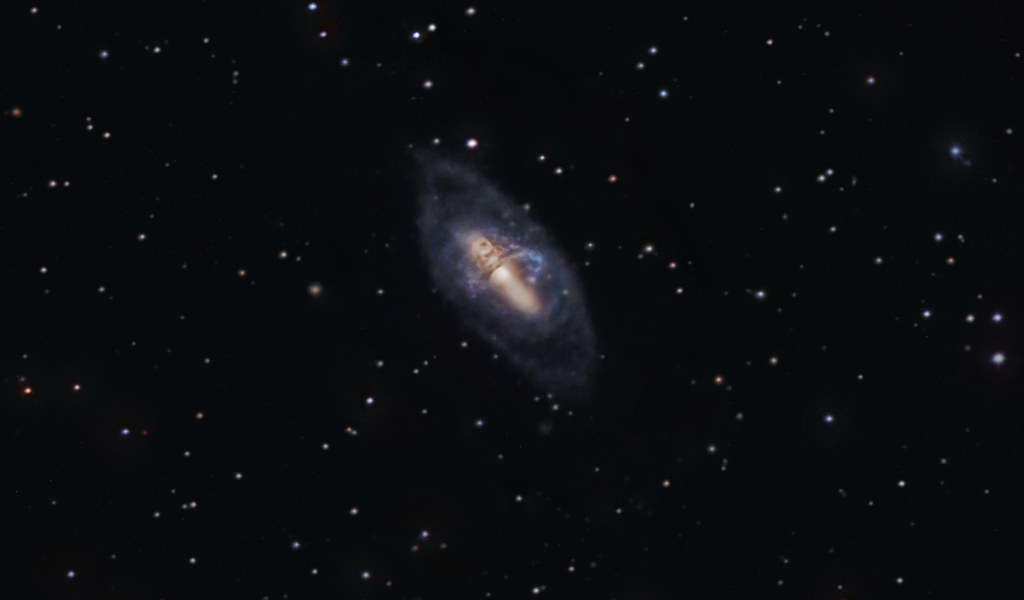Find out the latest thinking about our universe.
-
bystander
- Apathetic Retiree
- Posts: 21577
- Joined: Mon Aug 28, 2006 2:06 pm
- Location: Oklahoma
Post
by bystander » Wed May 23, 2018 7:34 pm
Spinning Rugby Balls: The Rotation of the Most Massive Galaxies
Leibnitz Institute for Astrophysics Potsdam - 2018 May 23
By targeting the most massive galaxies in our universe, astronomers have studied how their stars move. The results are surprising: while half of them spin around their short axis as expected, the other half turn around their long axis. Such kinematics are most likely the result of a special type of galaxy merger, involving already massive, similar-mass galaxies. This would imply that the growth of the most massive and the largest galaxies is governed by these rare events.
Measuring the way stars move within galaxies is a very powerful way of learning about the internal structure of galaxies, especially properties such as their three-dimensional shape and, ultimately, what their gravitational potential is like.
To study the largest and most massive galaxies, a science team led by Davor Krajnovic from the Leibniz Institute for Astrophysics Potsdam (AIP) selected a sample of some of the brightest galaxies up to a distance of 800 million light years. These live in large ensembles of galaxies, within some of the most densely populated regions of our Universe, such as the Shapley Supercluster. They are also very bright and rare. The most massive galaxies are about one hundred times more massive than our own galaxy the Milky Way, which itself already has a stellar mass of 60 billion suns. They also have almost no gas, most of their stars are very old (at least 10 billion years) and do not form stars anymore.
Unfortunately, these galaxies are too far from us to be resolved into individual stars and their motions. One can only look at the average motions of stars within certain regions. “This is what integral-field spectrographs are good at”, explains Davor Krajnović. „We observed these galaxies with MUSE, the wonderful integral-field spectrograph on the ESO's Very Large Telescope on Cerro Paranal in Chile. Massive galaxies can have all sorts of kinematics, some spin like frisbees, but most have no specific sense of rotation. We observed the most massive galaxies and found them to be different from other galaxies.” ...
Climbing to the Top of the Galactic Mass Ladder: Evidence for Frequent
Prolate-like Rotation Among the Most Massive Galaxies - Davor Krajnovic
et al
Know the quiet place within your heart and touch the rainbow of possibility; be
alive to the gentle breeze of communication, and please stop being such a jerk. — Garrison Keillor
-
neufer
- Vacationer at Tralfamadore
- Posts: 18805
- Joined: Mon Jan 21, 2008 1:57 pm
- Location: Alexandria, Virginia
Post
by neufer » Wed May 23, 2018 9:16 pm
http://www.theory.physics.manchester.ac.uk/~mikeb/lecture/pc167/rigidbody/poinsot.html wrote:
On the Poinsot Construction*
by David N. Williams
- When the polhode rolls on the herpolhode
invariably in the plane,
the forces tend to be free.
When the polhode slips on the herpolhode,
the forces are not mundane,
they're nonholonomic, you see!
*Inspired by a footnote to a discussion of the free rotation of a rigid body about its center of mass in Goldstein's Classical Mechanics,
"
Hence the jabberwockian sounding statement: the polhode rolls without slipping on the herpolhode lying in the invariable plane."
Art Neuendorffer
-
neufer
- Vacationer at Tralfamadore
- Posts: 18805
- Joined: Mon Jan 21, 2008 1:57 pm
- Location: Alexandria, Virginia
Post
by neufer » Fri May 25, 2018 11:56 am
Ann wrote: ↑Fri May 25, 2018 8:36 am
S_S wrote: ↑Fri May 25, 2018 5:32 am
I'm wondering, what's the big object seen in yellow color and dumbbell shape in southwest direction from center ? Is that a merging of 2 elliptical galaxies by chance ? Or something totally different ? Thanks for all answers/help in advance.
Polar ring galaxy NGC 2685. Photo: Greg Allegretti.
In my opinion, that is probably a lenticular galaxy with a disintegrating polar ring. In the picture at left, you can see polar ring galaxy NGC 2685. But the yellow dumbbell shaped galaxy in today's APOD seems to be entirely lacking in star formation, unlike NGC 2685. Also the dusty ring structures in NGC 2685 are sharply delineated, while in the dumbbell galaxy in the APOD, they seem to be evaporating.
NGC 2685 is probably a merger product, where the torn-apart remnant of a small spiral or an irregular galaxy has wrapped itself around the main galaxy's yellow bar.
It is possible that the yellow dumbbell in the APOD is also a merger product. But if so, the merger took place long ago, and the faint "belt" around the galaxy's "middle" is the only visible remnant of it.
https://en.wikipedia.org/wiki/NGC_2685 wrote:
<<NGC 2685 (also known as the Helix Galaxy) is a lenticular and polar ring Seyfert Type 2 galaxy in the constellation Ursa Major. It is about 50,000 light-years across and about 42 million light-years away from Earth. It is receding from Earth at 883 kilometers per second. It is an object of great scientific interest, because polar-ring galaxies are very rare galaxies. They are thought to form when two galaxies gravitationally interact with each other. "The bizarre configuration could be caused by the chance capture of material from another galaxy by a disk galaxy, with the captured debris strung out in a rotating ring. Still, observed properties of NGC 2685 suggest that the rotating ring structure is remarkably old and stable."
Allan Sandage referred to NGC 2685 as "perhaps the most peculiar galaxy in the Shapley-Ames Catalog".>>
Art Neuendorffer
